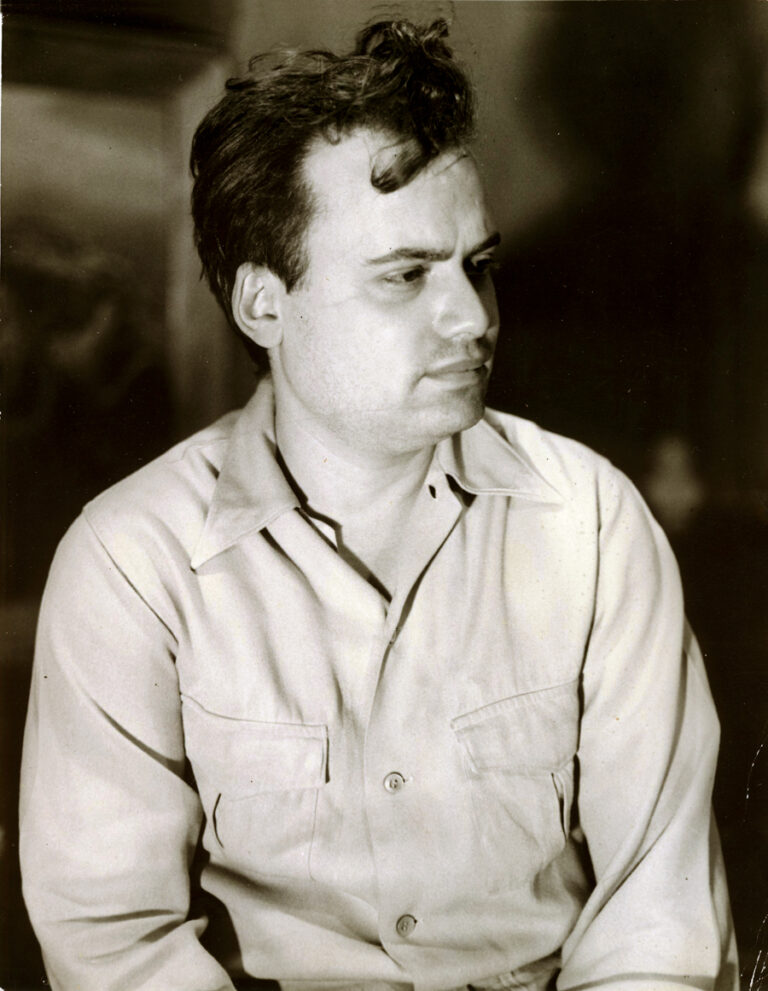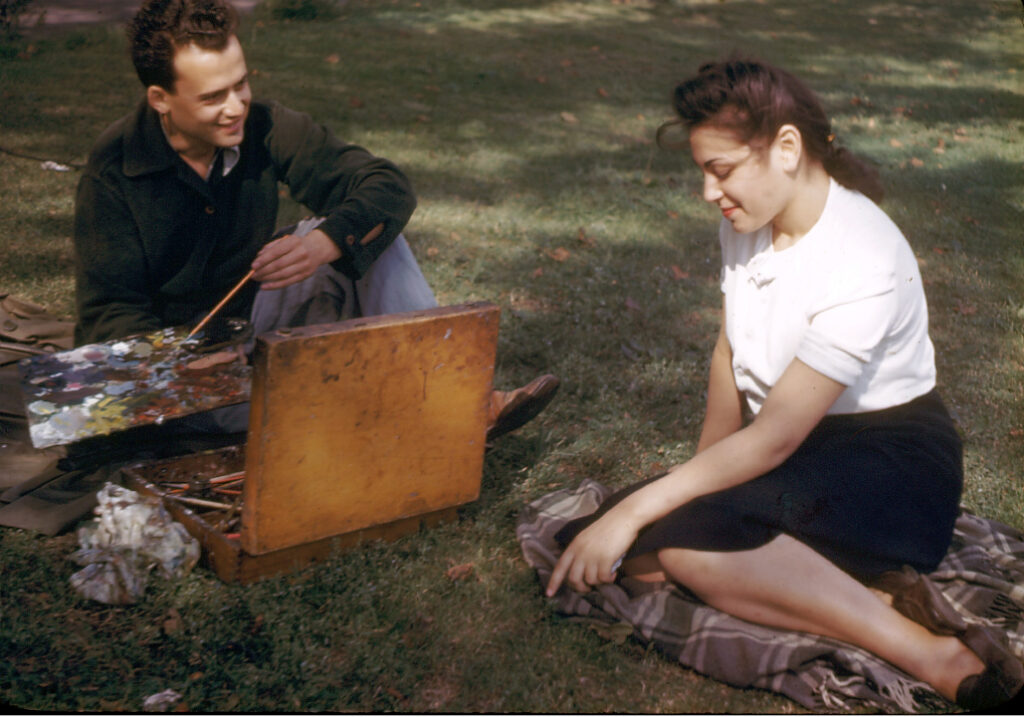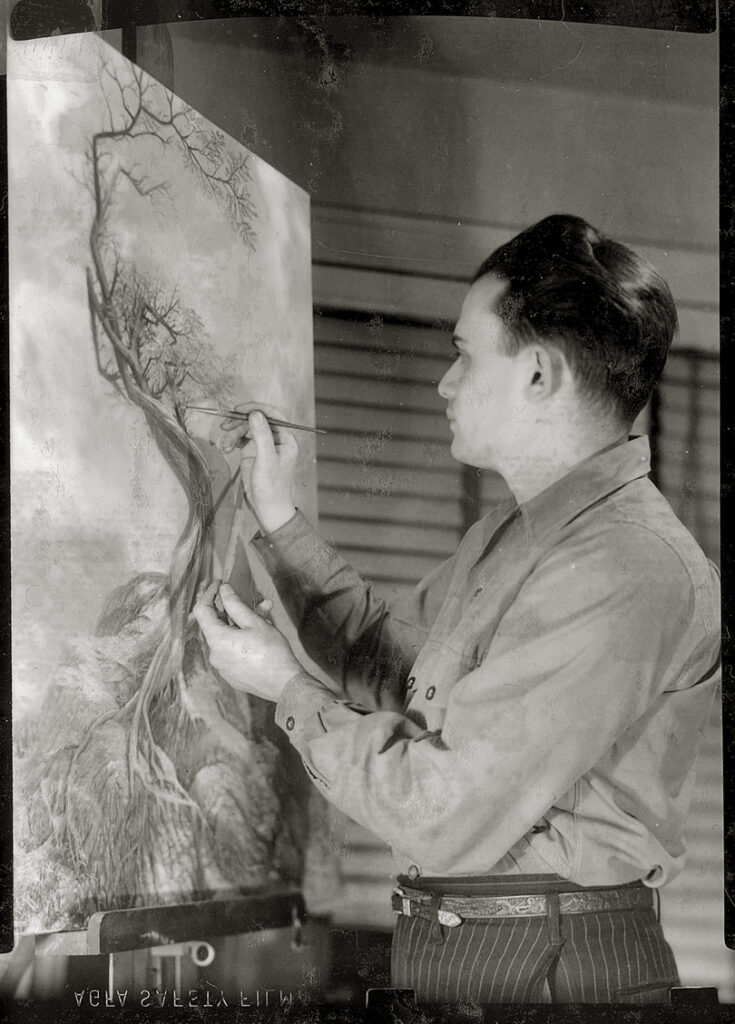Abe Weiner, In Retrospect

Life has relentless challenges, and change often comes with struggle and angst. It takes an extraordinary talent to capture these themes and turn them into a message that touches our lives. Abe Weiner had this talent. Weiner’s varied works exhibit extraordinary technical accomplishment yet at the same time leave us with a message that touches the depths of our senses and our experiences. Weiner’s work often reflects the dark themes of life itself, decay and destruction, struggle and anguish. Yet the contrasting theme in his paintings has always been regeneration, rebirth, renewal and hope. That message with its timeless thread is one we need to hear today and tomorrow.
Weiner’s varied works exhibit extraordinary technical accomplishment yet at the same time leave us with a message that touches the depths of our senses and our experiences. Weiner’s work often reflects the dark themes of life itself, decay and destruction, struggle and anguish. Yet the contrasting theme in his paintings has always been regeneration, rebirth, renewal and hope. That message with its timeless thread is one we need to hear today and tomorrow.
Abe Weiner was born November 5, 1917 in Pittsburgh, Pennsylvania. He lived his entire seventy five years in the city, and it often plays a prominent thematic role is his work, from the early Associated Artist award winner “Back of Isaly’s” to one of his final works, “Barnway”, a retrospective look at the street where he lived as a child. He loved his hometown and his work reflects the beauty of an American city growing, changing and being reborn. His legacy stretched far beyond his canvases. He was a master teacher and educator, adored by his students. He was a husband and father to three children. He loved all of his roles, doing each exceedingly well.

Abe Weiner’s technical excellence is evident in his repertoire. He prided himself on learning the nuances of color and texture along with the use of varied mediums to express just the right message. A graduate of Carnegie Technical Institute, now Carnegie Mellon University, he was influenced by instructors that demanded strong technique from their students. “I found the more technique I developed, the further I could take my paintings” [1] said Weiner in 1992. “At the time [of his education] we had instructors who were interested in technique, in the thought process and in understanding the visual process… instructors made me aware of the world in relationship to the way I worked.” That awareness made Weiner push the envelope with exacting skill, so much so that during the 1950 Carnegie International Exhibition, the museum considered putting “The Wall”, a painting with vivid textural effects and a subtle use of color, behind glass. Onlookers were so captivated by the realism that they wanted to “touch the cracks in the wall”!

But Weiner’s work was far more than technique with shapes and angles. Mastery was found in his extraordinary use of color, first with oil and tempera paints; later with acrylics. “His themes are the burgeoning of new life out of the old, futuristic landscapes that cup his views between holes in brick walls … or in eggshells.” [2]
He grew up during the tumultuous days of the Depression, coming of age prior to the outset of the Second World War. He loved nature and his works reflected a Rousseau like philosophy where the environment should be cherished, protected and never abused for human reasons. An environmentalist before his time, Weiner viewed nature as the core element of life itself. From the shoots of a young plant to the completeness and perfection of an egg, his work reflected the need for humanity to be in harmony with Creation. Yet his work depicted the scars made when society fought against nature as it struggled to grow and mature. Often his work caused the viewer to struggle to understand the meaning of a painting and he would observe them trying to analyze his work or “figure it out”. He enjoyed hearing about the meaning viewers would make from his paintings, believing he had something important to learn from them. “Like a poet, he [Weiner] deals visually with ideas that are hard to express, and yet he is moving in a quiet yet passionate way.” [3] A surreal realist, using common themes and likenesses in uncommon ways, Weiner was a renaissance man with a vision for the future. His paintings reflected 55 years of artistry.
Jonathan Weiner – January 9, 2004
[1] Older artists put up a good show, review by Cathy Lubenski . Tribune-Review, Sept. 6, 1991
[2] Retrospective Reflects Weiner’s Vision, review by Donald Miller . Pittsburgh Post Gazette, December 17, 1981 .
[3] Retrospective Reflects Weiner’s Vision, review by Donald Miller . Pittsburgh Post Gazette, December 17, 1981
Exhibits and Awards
Painting in United States – Invitational
Annual exhibition of selected American Artists
Carnegie Institute of Pittsburgh, Pittsburgh, PA
1946, 1947, 1948, 1949
Carnegie International – Invitational
Exhibition of selected American and International artists
Carnegie Institute of Pittsburgh, Pittsburgh, PA
1950 – 2nd Popular Prize
Associated Artists of Pittsburgh (Juried)
Carnegie Institute of Pittsburgh, Pittsburgh, PA
Exhibited annually from 1941-1959 and in later years.
1941 – First Prize. Purchase award (One Hundred Friends of Art.)
1945 – Second Prize
1957 – Popular Prize
1958 – Martin Leisser School of Design Prize
1959 – Honorable Mention
1976 – Purchase Award (One Hundred Friends of Art )
Participation in Invitational Exhibits
The Society for Contemporary American Art .
Chicago Art Institute, Chicago, Illinois – 1948
13th Annual New-Year Show
Butler Art Institute, Youngstown, Ohio – 1948
15th Annual New-Year Show
Butler Art Institute, Youngstown, Ohio – 1950
Honorable Mention
Life Magazine – Fifty Most Promising Painters in the United States.
Metropolitan Museum of Art . New York, New York – 1950
Pittsburgh Playhouse Exhibition
Pittsburgh Playhouse, Pittsburgh, PA – 1952
First Prize
The Ludgin Collection of Contemporary Art
Corcoran Gallery of Art , Washington, D.C. – 1954
Ten American Collectors
Contemporary Arts Museum, Houston, Texas – 1955
from the collection of Mr. and Mrs. Earle Ludgin
Other Invitational Shows
26th Annual Art Exhibition
Latrobe Public Schools – 1951
Purchase Award, One Hundred Friends of Art
Herron Art Institute, Indianapolis, Indiana – 1954, 1955
Westmoreland Museum of Art, Greensburg, Pennsylvania – 1964
Three Rivers Arts Festival
Outdoor Exhibit, Pittsburgh, PA – 1968
Variations on a City First Prize (Purchase Award)
One Man Show
Ivy School of Professional Art , Pittsburgh, PA 1968
University of Pittsburgh Solo Exhibition
UP Gallery, Pittsburgh PA – 1981
70+ and Working
Exhibition of Pittsburgh Artists over 70 years old
Jewish Community Center, Pittsburgh, PA – 1991
COMMISSIONS
ALCOA (Aluminum Company of America), Pittsburgh, PA – 1958
Mixed Media – aluminum and egg tempera, on aluminum
TEACHING:
Ivy School of Professional Art – Pittsburgh, PA
Assistant Director, 1961-1972
Teacher of Drawing and Painting, 1961-1980
Pittsburgh Center for the Arts
Teacher of Drawing and Painting, 1965-1993
Irene Kaufman Center (YM&WHA)
1956-1960
LECTURER AND ART JUROR:
Lectured and judged many art exhibits in the Pittsburgh area including Butler, Kittanning Art Association, Vandergrift, and New Kensington Art shows.
EDUCATION:
Certificate, Carnegie Institute of Technology – 1941
Department of Painting and Design
Studied with Samuel Rosenberg and Robert Gwathmey
BIBLIOGRAPHY LISTINGS:
Habarta, Gerhard. Lexikon der Phantastischen Kunstler.
The International Encyclopedia of Fantastic, Surrealistic, Symbolist and Visionary Artists. German Edition. 2009. (pages 435,439)
Lorant , Stefan . Pittsburgh (1964)
(Painting, Back of Isaly’s, used as depiction of Pittsburgh). Doubleday Press.